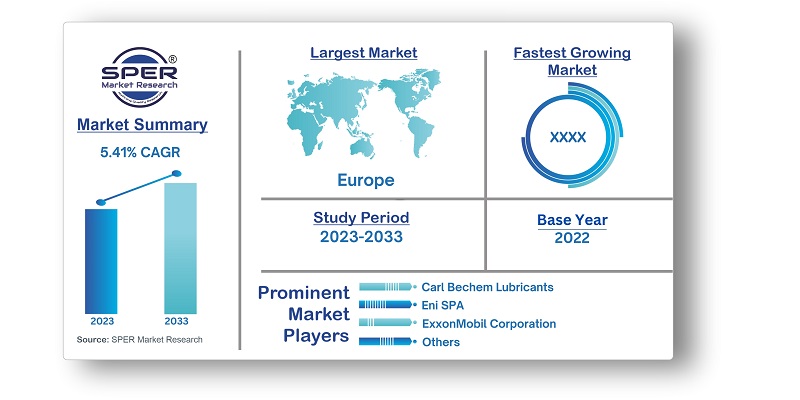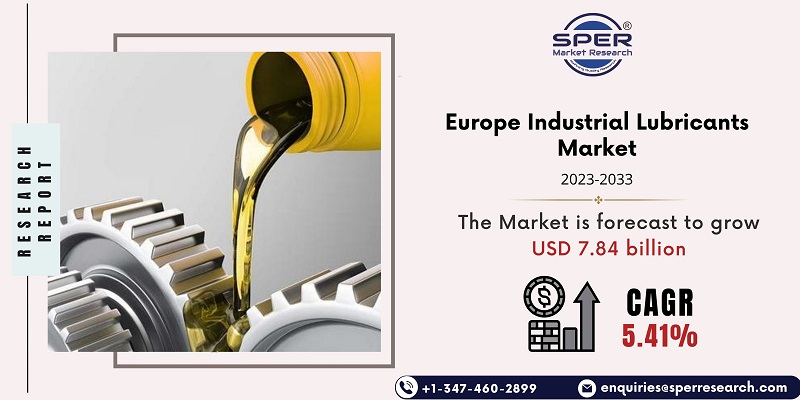
Europe Industrial Lubricants Market Growth, Size, Trends, Revenue, Share and Future Competition
Europe Industrial Lubricants Market Size- By Product Type, By Base Oil, By End User- Regional Outlook, Competitive Strategies and Segment Forecast to 2033
| Published: Dec-2023 | Report ID: CHEM23118 | Pages: 1 - 153 | Formats*: |
| Category : Chemical & Materials | |||
- January 2022: Motul is a French oil company that was founded in 1853. It introduced the TEKMA line of heavy-duty lubricants for diesel engines. These engine oils were developed especially to function in the most demanding situations. According to the manufacturer, TEKMA engine oils can offer better engine protection, longer drain intervals, and higher power and fuel efficiency.


| Report Metric | Details |
| Market size available for years | 2019-2033 |
| Base year considered | 2022 |
| Forecast period | 2023-2033 |
| Segments covered | By Product Type, By Base Oil, By End User |
| Regions covered | BENELUX, France, Germany, Italy, Spain, United Kingdom, Rest of Europe |
| Companies Covered | Carl Bechem Lubricants, Eni SPA, ExxonMobil Corporation, Fuchs Petrolub SE, Klüber Lubrication, Motul S.A., Nynas AB, PJSC Gazprom, PJSC Lukoil, PJSC Rosneft Oil, Repsol SA, Shell plc., TotalEnergies SE, Valvoline, Inc., Others |
- Aerospace Industry
- Automotive Sector
- Construction Companies
- Engineering and Maintenance Services
- Manufacturing Industries
- Maritime Industry
- Mining Operations
- Oil and Gas Sector
- Power Generation Plants
- Transportation and Logistics
- Others
| By Product Type: |
|
| By Base Oil: |
|
| By End User: |
|
- Europe Industrial Lubricants Market Size (FY’2023-FY’2033)
- Overview of Europe Industrial Lubricants Market
- Segmentation of Europe Industrial Lubricants Market By Product Type (Compressor Oil, Gear Oil, Grease, Hydraulic Fluids, Metal Working Fluids, Refrigeration Oil, Textile Machinery Lubrications, Transformer Oil, Turbine Oil, Others)
- Segmentation of Europe Industrial Lubricants Market By Base Oil (Bio-based Oil, Mineral Oil, Synthetic Oil)
- Segmentation of Europe Industrial Lubricants Market By End User (Agriculture, Automotive, Cement Production, Chemical Production, Construction, Food Processing, Marine Applications, Metal & Mining, Oil and Gas, Power Generation, Pulp and paper, Textile Manufacturing, Others)
- Statistical Snap of Europe Industrial Lubricants Market
- Expansion Analysis of Europe Industrial Lubricants Market
- Problems and Obstacles in Europe Industrial Lubricants Market
- Competitive Landscape in the Europe Industrial Lubricants Market
- Impact of COVID-19 and Demonetization on Europe Industrial Lubricants Market
- Details on Current Investment in Europe Industrial Lubricants Market
- Competitive Analysis of Europe Industrial Lubricants Market
- Prominent Players in the Europe Industrial Lubricants Market
- SWOT Analysis of Europe Industrial Lubricants Market
- Europe Industrial Lubricants Market Future Outlook and Projections (FY’2023-FY’2033)
- Recommendations from Analyst
1.1. Scope of the report1.2. Market segment analysis
2.1. Research data source2.1.1. Secondary Data2.1.2. Primary Data2.1.3. SPER’s internal database2.1.4. Premium insight from KOL’s2.2. Market size estimation2.2.1. Top-down and Bottom-up approach2.3. Data triangulation
4.1. Driver, Restraint, Opportunity and Challenges analysis4.1.1. Drivers4.1.2. Restraints4.1.3. Opportunities4.1.4. Challenges4.2. COVID-19 Impacts of the Europe Industrial Lubricants Market
5.1. SWOT Analysis5.1.1. Strengths5.1.2. Weaknesses5.1.3. Opportunities5.1.4. Threats5.2. PESTEL Analysis5.2.1. Political Landscape5.2.2. Economic Landscape5.2.3. Social Landscape5.2.4. Technological Landscape5.2.5. Environmental Landscape5.2.6. Legal Landscape5.3. PORTER’s Five Forces5.3.1. Bargaining power of suppliers5.3.2. Bargaining power of buyers5.3.3. Threat of Substitute5.3.4. Threat of new entrant5.3.5. Competitive rivalry5.4. Heat Map Analysis
6.1. Europe Industrial Lubricants Market Manufacturing Base Distribution, Sales Area, Product Type6.2. Mergers & Acquisitions, Partnerships, Product Launch, and Collaboration in Europe Industrial Lubricants Market
7.1. Europe Industrial Lubricants Market Value Share and Forecast, By Product Type, 2023-20337.2. Compressor Oil7.3. Gear Oil7.4. Grease7.5. Hydraulic Fluids7.6. Metal Working Fluids7.7. Refrigeration Oil7.8. Textile Machinery Lubrications7.9. Transformer Oil7.10. Turbine Oil7.11. Others
8.1. Europe Industrial Lubricants Market Value Share and Forecast, By Base Oil, 2023-20338.2. Bio-based Oil8.3. Mineral Oil8.4. Synthetic Oil
9.1. Europe Industrial Lubricants Market Value Share and Forecast, By End User, 2023-20339.2. Agriculture9.3. Automotive9.4. Cement Production9.5. Chemical Production9.6. Construction9.7. Food Processing9.8. Marine Applications9.9. Metal & Mining9.10. Oil and Gas9.11. Power Generation9.12. Pulp and paper9.13. Textile Manufacturing9.14. Others
10.1. Europe Industrial Lubricants Market Size and Market Share
11.1. Europe Industrial Lubricants Market Size and Market Share By Product Type (2019-2026)11.2. Europe Industrial Lubricants Market Size and Market Share By Product Type (2027-2033)
12.1. Europe Industrial Lubricants Market Size and Market Share By Base Oil (2019-2026)12.2. Europe Industrial Lubricants Market Size and Market Share By Base Oil (2027-2033)
13.1. Europe Industrial Lubricants Market Size and Market Share By End User (2019-2026)13.2. Europe Industrial Lubricants Market Size and Market Share By End User (2027-2033)
14.1. Europe Industrial Lubricants Market Size and Market Share By Region (2019-2026)14.2. Europe Industrial Lubricants Market Size and Market Share By Region (2027-2033)14.3. BENELUX14.4. France14.5. Germany14.6. Italy14.7. Spain14.8. United Kingdom14.9. Rest of Europe
15.1. Carl Bechem Lubricants15.1.1. Company details15.1.2. Financial outlook15.1.3. Product summary15.1.4. Recent developments15.2. Eni SPA15.2.1. Company details15.2.2. Financial outlook15.2.3. Product summary15.2.4. Recent developments15.3. ExxonMobil Corporation15.3.1. Company details15.3.2. Financial outlook15.3.3. Product summary15.3.4. Recent developments15.4. Fuchs Petrolub SE15.4.1. Company details15.4.2. Financial outlook15.4.3. Product summary15.4.4. Recent developments15.5. Klüber Lubrication15.5.1. Company details15.5.2. Financial outlook15.5.3. Product summary15.5.4. Recent developments15.6. Motul S.A.15.6.1. Company details15.6.2. Financial outlook15.6.3. Product summary15.6.4. Recent developments15.7. Nynas AB15.7.1. Company details15.7.2. Financial outlook15.7.3. Product summary15.7.4. Recent developments15.8. PJSC Gazprom15.8.1. Company details15.8.2. Financial outlook15.8.3. Product summary15.8.4. Recent developments15.9. PJSC Rosneft Oil15.9.1. Company details15.9.2. Financial outlook15.9.3. Product summary15.9.4. Recent developments15.10. Repsol SA15.10.1. Company details15.10.2. Financial outlook15.10.3. Product summary15.11. Shell plc15.11.1. Company details15.11.2. Financial outlook15.11.3. Product summary15.11.4. Recent developments15.12. TotalEnergies SE15.12.1. Company details15.12.2. Financial outlook15.12.3. Product summary15.12.4. Recent developments15.13. Valvoline, Inc.15.13.1. Company details15.13.2. Financial outlook15.13.3. Product summary15.13.4. Recent developments15.14. Others
SPER Market Research’s methodology uses great emphasis on primary research to ensure that the market intelligence insights are up to date, reliable and accurate. Primary interviews are done with players involved in each phase of a supply chain to analyze the market forecasting. The secondary research method is used to help you fully understand how the future markets and the spending patterns look likes.
The report is based on in-depth qualitative and quantitative analysis of the Product Market. The quantitative analysis involves the application of various projection and sampling techniques. The qualitative analysis involves primary interviews, surveys, and vendor briefings. The data gathered as a result of these processes are validated through experts opinion. Our research methodology entails an ideal mixture of primary and secondary initiatives.



Frequently Asked Questions About This Report
PLACE AN ORDER
Year End Discount
Sample Report
Pre-Purchase Inquiry
NEED CUSTOMIZATION?
Request CustomizationCALL OR EMAIL US
100% Secure Payment






Related Reports
Our Global Clients
Our data-driven insights have influenced the strategy of 200+ reputed companies across the globe.




















